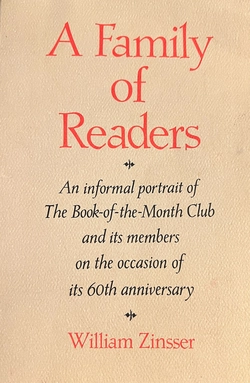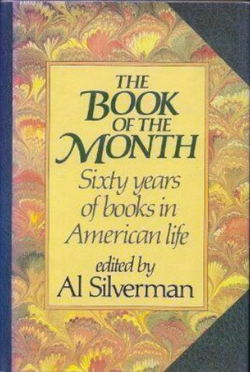You know about influencers on BookTok, Bookstagram, and BookTube, but what do you know about Book of the Month? Before social media influencers, Book of the Month (formerly Book-of-the-Month Club) paved the way for direct-to-reader book sales, and it continues to do so today—without physical bookstores, and without traditional marketing.
Booksellers and self-publishing authors, on the other hand, struggle to sell books. They advertise on Amazon and other various platforms, blast social media with ineffective posts, and ultimately fail to gain any traction. But Book of the Month sidesteps Amazon and is widely successful on social media. Is their existence proof that you don’t need fancy bookstore displays or big-five publisher budgets to sell books?
In this article, I explore this by researching Book of the Month, its history, and how booksellers (like you and me) can sell just like they do:
Note: If you’re looking for a history of Book of the Month book selections dating back to 1926, check out my list.

What is the Book of the Month (BOTM)?
Book of the Month is an online book subscription service that markets to millennial women through social media such as Instagram and TikTok. Each month, its editorial staff selects 5-7 books from both independent and major publishers to recommend to its members. Members use site-purchased credits to receive a hardcover book selection in the mail or an audiobook in the BOTM app. They may also choose to skip the month.
As of today, Book of the Month has 1.3 million Instagram followers and its daily posts average between 1,000-2,000 likes. Impressive numbers, for sure.
But before its modern online version, Book-of-the-Month Club marketed to all American readers through newspapers, magazines, and the U.S. Postal Service. It took a few years for bookstores and publishers, who denounced the Club’s discounted prices and sales tactics, to approve of the sales-by-mail model. Regardless of industry approval though, Harry Scherman, the Club’s founder, charged forward with his plan. He wanted to sell books directly to readers without middlemen.
By the 1940s, the Book-of-the-Month Club was a major success. It had bypassed traditional rails, became a cultural institution and bookselling machine, and gained over 880,000 subscribers.[1] Many of the Club’s selections became bestsellers, Pulitzer Prize winners, and National Book Award recipients.
Following a decline in membership during the early 2000s, the Club underwent various ownership changes and eventually evolved into an online subscription service that uses social media as its primary marketing tool.
History of the Book of the Month
Throughout its history, Book of the Month’s operations have evolved. Its marketing strategies, however, have remained focused on the same principles:
Establishing cultural influence/authority
Providing value for its members (deals!)
Effective marketing directly to readers
These basic principles led to various innovations, including the manufacture of special editions, the implementation of the “Book-Dividend,” and the invention of the “negative option.”
Below is a timeline documenting the evolution of the Book-of-the-Month Club, along with some historical context. If you’re looking to learn more about the history of the Book of the Month, I suggest checking out these books.
For the history of Book-of-the-Month Club book selections, see my database.
Timeline
1926
Harry Scherman founds the Book-of-the-Month Club.
Scherman selects literary celebrities, or “judges,” to make monthly book selections:
Henry Seidel Canby, Yale English professor and The Saturday Review editor
Dorothy Canfield Fisher, best-selling author and activist
William Allen White, editor of the Emporia Gazette and politician
Heywood Broun, journalist and founder of the American Newspaper Guild
Christopher Morley, journalist and novelist
The judges’ selections are reportedly uninfluenced by Club management.
Lolly Willowes by Sylvia Townsend Warner is the first monthly selection.
Historical Context
Companies, including printing manufacturers, have embraced the assembly line, invented by Henry Ford, for mass production of goods.
Books and magazines are popular, but scant in most of America. Bookstores and libraries are uncommon in towns and rural areas and, therefore, demand for books is high.
Radio and movies are costly entertainment. Books are more affordable.
1927-1939
A main selection, The Heart of Emerson’s Journals, is returned in mass by Club members.
As a result, Book-of-the-Month Club invents the “negative option,” which allows members to accept, deny, or exchange a selection before delivery.
The Club does not offer refunds on books, but it allows exchanges.
Cradle of the Deep, a nonfiction selection in 1929, is reported to be a hoax by various newspapers. More than half of its sales are exchanged (no refunds are offered).[2]
Printing of special Book-of-the-Month Club editions begins in 1930.
Book acquisition costs are lowered and marketing is boosted by adding the Book-of-the-Month Club name to each book. Publishers earn royalties from each printed copy.
In 1950, the Club creates the “Book-Dividend Fund.” Free books, or “book-dividends” are offered to members who accept (purchase) a minimum number of monthly selections.
Marketing language: “[U]nder the unique book-dividend policy of the Club, for every dollar its members spend on books they receive back on the average over 50% in the form of free books.”[3]
“Book-Dividend” marketing appeals to value shoppers.
Historical Context
The Great Depression begins after the stock market crash in October 1929 and lasts until 1939.
Americans have less money to spend.
1940-1969
The “alternate” plan begins in 1950, giving members more options and allowing the Club’s editorial staff to recommend books other than main selections.
Alternate selections now carry a formal designation.
The Club expands its offerings to include art reproductions, art education courses, niche book clubs, musical record clubs, and Christmas cards.
Membership reaches 1 million in the mid-1960s.[1]
Historical Context
Book clubs are common in America, and many appeal to special interests.
Book-of-the-Month Club becomes a publicly listed company in 1947. It’s ticker: BOMC.
Art replica sales, record sales, and Christmas card sales help the Club achieve higher profits for shareholders.
1980-1990
By 1986, the Book-of-the-Month Club monthly offerings include one main book selection, up to ten alternates, and a backlist of 125 additional book titles. The Club manufactures more than 90% of its books.[4]
Time Warner, the Club’s parent company, restructures Book-of-the-Month Club operations to increase profit.
The Club begins purchasing future rights to unpublished works by famous authors, and these purchases often become selections, sometimes with little review from the judges.
For the first time, the judge’s main selections are highly influenced by editorial staff and upper management.
Historical Context
Time Warner purchases the Book-of-the-Month Club in 1977 but allows it to operate on its own until the mid-80s.
Large retailers such as Walmart are selling books at lower prices than book clubs.
1990-1999
The Club begins using computers to compile data about member preferences and habits. They determine that reference books, religious books, and anthologies are most popular.[5]
The judges are disbanded in 1994.
Historical Context
Companies are embracing computers for business operations.
Jeff Bezos founds Amazon and focuses on selling books online. By 1998, Amazon has acquired various online booksellers and is growing rapidly.
In 1996, Oprah Winfrey starts Oprah’s Book Club as a segment on her daytime talk show.
2000-2005
After the apparent success of Oprah’s Book Club, the Club reinstates celebrity judges in 2001. They hire authors Nelson DeMille (The General’s Daughter), Annie Proulx (Brokeback Mountain), Bill Bryson (A Walk in the Woods), and Anna Quindlen (One True Thing).[6] In 2005, the judges are again disbanded.
The Club begins making multiple book selections per month. Members may choose from five categories: Mystery and Suspense, History and Biography, Fiction, Home and Health, and Current Affairs.[7]
Members begin choosing their book selections online.
Historical Context
Oprah’s Book Club is successful in selling books, demonstrating that: 1) endorsements from non-literary celebrities are effective and 2) celebrities (and their brands) have fans with unique (and targetable) demographics.
2012-Today
Book-of-the-Month Club (BOMC) relaunches as an online subscription service and is renamed Book of the Month, LLC (BOTM).
In 2015, BOTM reinstates judges and provides up to five monthly book selections for members.
For the first time, BOTM narrows its marketing efforts. Initially, marketing appears to target women Baby Boomers and Generation X, not millennials. (See The Me Me Me Generation | Book of the Month, an article where a judge complains about millennials.)
By 2018, the position of “judge” is minimized, and monthly selections are ultimately made by the BOTM editorial staff.
Instead of retaining judges on staff, BOTM partners with celebrities and book influencers to market selections.
BOTM now focuses its marketing efforts on the largest demographic of book buyers—millennial women. They advertise primarily on social media.
Historical Context
Companies embrace social media marketing, which is successful among millennial women. Subscription Box services such as Stitch Fix and Blue Apron thrive.
Cultural Influencers
Today, the Book of the Month’s use of influencers, special edition printings, and a podcast effectively establish their cultural influence in the bookselling world. However, cultural influence has been their forte since their establishment nearly a century ago.
When Harry Scherman founded the Book-of-the-Month Club in 1926, he promptly began establishing the Club’s literary authority. His first picks for the Club’s judges, who were to select each book-of-the-month, were literary celebrities: Henry Seidel Canby, Dorothy Canfield Fisher, William Allen White, Heywood Broun, and Christopher Morley.
If a reader in middle America didn’t know who the judges were, well, the Club told them in the extensive ads it placed in newspapers and magazines. The Club’s first advertisements in Vogue featured headshots of each judge.[8] These judges’ literary celebrity legitimized the Book-of-the-Month Club, and as a result, it sold thousands, and eventually millions, of books.
Besides using star power, Harry Scherman found a way to print the Club’s name on its selections. In 1930, Book-of-the-Month Club began printing special edition books.
Initially conceived to reduce the cost of acquiring books, the Club manufactured the special editions themselves, thus removing the need to purchase books wholesale from publishers. In return for paying royalties, the Book-of-the-Month Club could stamp their logo on every book they printed. From this point on, thousands (sometimes millions) of books with the Club’s name were distributed each year, helping to expand its cultural influence.
Year after year, newspaper and magazine journalists continued to report on the Club’s monthly selections, their authors, and changes to its offerings or judges’ panel. The New York Times, Washington Post, and Publisher’s Weekly are a few publications that reported on the Book-of-the-Month Club.
Starting in the 1940s and lasting until today, the Club has used its influence to sell more than books. Until the 1980s, Book-of-the-Month Club members could purchase art reproductions, at-home art education courses, niche books from one of its many other book clubs, musical records, and Christmas cards. These offerings are no longer available, but the current Book of the Month’s Blue Box Boutique is reminiscent of the approach.
How to Sell Books like Book of the Month

If you want to sell books, Book of the Month's model is a great place to start. Here is their general process.
1. Discover who wants your books
In 1926, Harry Scherman observed that American readers had limited access to new books, which led him to believe that there was a demand for books all over America. As for today’s Book of the Month, sales show that it’s millennial women who like to read—or at least like to buy books.
For you, it depends on the type of book(s) you want to sell, but narrowing your buyers to a specific demographic can help you appeal to them. Examples: Middle-aged men who love cooking, young women who race go-karts, goth teens who love dragons.
2. Find what “speaks to” your buyers
For the Book-of-the-Month Club members in the 1930s, it was a panel of literary judges, newspaper articles, and finding Club books on friends and family’s bookshelves. Today’s Book of the Month members like Instagram images of beautifully staged books and referrals from their favorite book influencer.
Perhaps for your buyers, it’s instructional YouTube videos, angsty posts on X, or a pet food blog.
3. Establish Influence
The Book of the Month, both in the past and the present, found ways to establish influence and authority for selecting good books. They connected with influencers/celebrities, wrote in-depth reviews in a monthly newsletter, and provided regular streams of authoritative information about their offerings.
For you, this means finding what your buyers care about (demographics), going wherever they are (social media or other), and committing to regularly giving them information they value.
4. Market directly to your buyers
For the Book-of-the-Month Club in the 1930s and up to the 2000s, this meant deals and newsletters sent straight to a potential customer’s mailbox. Today’s Book of the Month uses targeted social media ads, its sleek mobile app, and a podcast.
For you, there’s good news! You have access to the same marketing and communication tools that Book of the Month uses! If you’re on a limited budget, try establishing some sort of influence before paying for marketing. Social media, blogs, email, and meeting people in person may take time to generate results, but they’re typically free.
5. Add value (or deals!)
In the 1930s, this meant very low introductory offers (to hook them), free books from the “Book Dividend Fund,” and a monthly newsletter with tons of book reviews. Today’s Book of the Month uses the occasional discount code, “add-on” deals, and an engaged book review community.
For you, it means determining what “value” means to your buyers and using this knowledge to entice them with deals encouraging them to buy more. Do what makes your buyers feel like they get more than what they pay for, especially if they’re loyal customers.
6. Amplify Your Influence
When you’re ready to amplify your influence, it means you’re ready to increase your sales momentum. For the Book-of-the-Month Club in the 1940s, this meant expanding deals with bookstores, offering art reproductions to their members, and staying in contact with authors and publishers, who were sometimes interviewed for newspapers. For today’s Book of the Month, it means highlighting social media posts of their members (particularly ones with large followings), inviting celebrities and influencers to comment on their upcoming selections, and inviting authors to chat on their podcast.
This step is most effective when you’ve established influence. The goal is to do what you can to get others to talk about you and recommend your book.
7. Repeat
The Book of the Month has always been most successful when it adapts, and part of adapting is being ready to reevaluate and then repeat what works.


